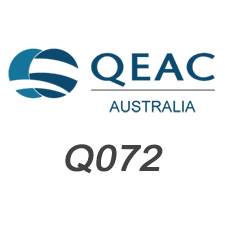Job ready Program Applicant Guidelines
The Job Ready Program
Section 1 Program Information
1.1 Introduction to Trades Recognition Australia
Trades Recognition Australia (TRA) is a business unit located within the Australian Government Department of Education, Skills and Employment (the Department). It is the relevant skills assessing authority for nominated occupations under the Migration Regulations 1994.
TRA skills assessments are intended to ensure that a successful applicant is able to perform at the required skill level for their nominated occupation. They also provide an assurance to government and to the individual that their training and experience is relevant and appropriate for the Australian labour market.
TRA operates several different skills assessment services, which are based on an applicant’s occupation, country of passport, where they studied and the type of visa they are seeking.
1.2 Program objective
The Job Ready Program (JRP) is for international student graduates who have studied at and received a completed qualification issued by a Registered Training Organisation (RTO). The RTO must be registered under the Commonwealth Register of Institutions and Courses for Overseas Students (CRICOS) to deliver the training.
It is a four‐step employment‐based skills assessment program that provides applicants with the opportunity to demonstrate skills and job readiness in an Australian workplace, relevant to a nominated occupation, before applying for migration in Australia.
The JRP aims to ensure that a skilled worker is well placed to seek employment in their nominated occupation in Australia. The four steps in the JRP are outlined in Section 2 and include:
- Provisional Skills Assessment (PSA)
- Job Ready Employment (JRE)
- Job Ready Workplace Assessment (JRWA)
- Job Ready Final Assessment (JRFA)
1.3 Program Guidelines
These Guidelines describe the JRP and outline the requirements for applicants who wish to participate in the program. Following completion of the program, applicants may apply for temporary or permanent migration to Australia.
You must read the eligibility requirements for the JRP before starting an application. If you do not understand any part of the eligibility requirements, please contact TRA via the TRA website www.tradesrecognitionaustralia.gov.au
These Guidelines do not provide specific information on visa or points requirements for migration. All enquiries relating to migration requirements must be directed to the Australian Department of Home Affairs (Home Affairs) (www.homeaffairs.gov.au).
TRA reserves the right to amend these Guidelines as necessary. Information about changes will be documented in the Change History Table in Section 5, and posted as a news item on the TRA website www.tradesrecognitionaustralia.gov.au.
1.4 Before applying for the JRP
Before applying for the JRP, you should contact Home Affairs to ensure you have identified the appropriate visa pathway and check that TRA is listed as the assessing authority for your nominated occupation.
If you are intending to apply for Temporary Graduate Visa (subclass 485), you should also check that your nominated occupation is on the Medium and Long‐term Strategic Skills List on the Home Affairs website www.homeaffairs.gov.au.
1.5 How to apply
To apply for the program you must register for the JRP through the TRA Online Portal via the TRA website www.tradesrecognitionaustralia.gov.au. Select the Job Ready Program Registration and complete the registration details.
A TRA reference number and username will be generated and you will be asked to create a password. You will need your username and password to sign into your online account. Diagram 1 below provides an overview of the online application process.
Diagram 1: JRP application process

All applications submitted to TRA must be ‘decision ready’. ‘Decision ready’ means all the mandatory fields in the TRA Online Portal are completed, all documents are uploaded as required under these Guidelines, and the mandatory application fee is paid.
Please read the instructions in the TRA Online Portal carefully to make sure you have met all requirements before submitting your documents.
1.5.1 Document requirements
Documentation provided as part of your application or as requested by TRA must be in PDF format and uploaded through the TRA Online Portal.
Please note, TRA cannot accept documents that are sent through file sharing platforms, such as Google Drive and Dropbox, and your application must not contain documents that are locked or password protected.
1.6 Fees
| Assessment Service | Fee |
| Step 1: Provisional Skills Assessment | $300 |
| Provisional Skills Assessment Review (if required) | $300 |
| Step 2: Job Ready Employment | $500 |
| Step 3: Job Ready Workplace Assessment | $2,000 |
| Subsequent Job Ready Workplace Assessment (if required) | $2,000 |
| Step 4: Job Ready Final Assessment | $150 |
Payments can only be made with a Visa or MasterCard credit/debit card through the TRA Online Portal. All fees are payable in Australian dollars, and instructions on how to pay are provided when you apply for each step of the program.
After payment, an email containing the receipt will be sent automatically to the email address you (and your agent if applicable), provided in your application. It is important to keep the email receipt as evidence of payment. This email provides confirmation that your application has been received by TRA.
1.6.1 Fee refunds
Refunds will not be provided should you choose to withdraw your application.
The circumstances in which TRA will refund a payment are detailed in the TRA Payment and Refund Policy on the TRA website www.tradesreognitionaustralia.gov.au.
Section 2 Program Requirements and Processes
The JRP is a four step employment‐based skills assessment program. To complete the JRP you must complete each of the steps shown in the Diagram 2.
Diagram 2: JRP steps

You should familiarise yourself with the eligibility requirements for each step of the program before you apply. Eligibility requirements must be met and these may differ slightly from Step 1 (PSA) to Step 2 (JRE). For example, TRA does not accept certain visa types for Step 2 of the program. (See section 2.2.1 of the Guidelines)
The following provides detailed information about the requirements of each step of the program.
2.1 Step 1: Provisional Skills Assessment (PSA)
Under PSA, TRA will confirm your identity and verify the authenticity of your Australian qualification, and that you have had exposure to a range of tasks and duties relevant to your nominated occupation in an Australian workplace.
A successful PSA outcome can be used to apply to Home Affairs for a Temporary Graduate visa (subclass 485). A successful PSA outcome is required before you can apply for Step 2 JRE of the JRP.
2.1.1 Eligibility
To be eligible for a PSA you must have:
- held an international student visa (as the primary visa holder) to study in Australia
- a qualification relevant to an occupation assessed by TRA, and awarded by a CRICOS RTO as a result of study in Australia
- evidence of a minimum of 360 hours of employment and/or a vocational placement relevant to your qualification and nominated occupation, completed in an Australian workplace, within the three years prior to submitting a PSA application
2.1.2 Online application process
To apply for the PSA you must register through the TRA Online Portal on the TRA website www.tradesrecognitionaustralia.gov.au. (see section 1.5 of the Guidelines).
You should then select the Provisional Skills Assessment link and follow the guidance to complete the Provisional Skills Assessment application, pay the application fee and upload the application documents listed in section 2.1.3 of the Guidelines. Your application cannot be submitted until all required documents are uploaded on the TRA Online Portal.
2.1.3 Application documents
Your PSA application documents must be uploaded in PDF format and include the following:
- a copy of the passport identification page of your current If the qualification you are submitting was completed under a different passport, a copy of the passport identification page of your previous passport must also be included;
- a current passport‐size photograph of you;
- a copy of your Australian qualification(s) relevant to your nominated occupation;
- the full academic transcript of results for all of your qualification(s), including the commencement and completion dates of study in Australia; and
- evidence of a minimum of 360 hours of employment and/or a vocational placement relevant to your qualification and nominated
Employment evidence requirements:
- copies of pay evidence such as pay slips or payroll printouts to support any periods of claimed employment completed in Australia in the last three years. Pay slips must show the hours worked or the hourly rate of pay.
Subcontracting arrangements may be accepted if it was with a single contractor who can confirm in a written statement the nature of the work you have done, the hours completed, and is accompanied by copies of invoices and bank statements. Invoices must show the hours worked or the hourly rate of pay and be accompanied by bank statements that clearly show the invoiced deposits from the contractor.
- copies of work statements from your employer/contractor to support claims of any employment undertaken in an Australian workplace in the last three years. The work statement must:
- be on letterhead used by your employer’s business;
- state the occupation in which you were employed;
- state the exact dates and total hours of employment;
- include a detailed description of the nature and content of the work undertaken, along with the machines, tools and/or equipment used; and
- be signed and dated by the employer or a person authorised by the employer, including: the name, position and telephone contact details of the person making the statement.
Vocational placement evidence requirements:
- copies of timesheets or log books to support any periods of claimed vocational placements completed in Australia in the last three years. Timesheets or logbooks must show the hours worked.
- copies of work statements from the RTO to support your claims of vocational placements completed in Australia in the last three years. Work statements for vocational placements must:
- be on letterhead used by the RTO;
- confirm the vocational placement was undertaken as a requirement of a training course;
- state the exact dates, hours and location of the vocational placement;
- include a detailed description of the nature and content of the work undertaken along with the machines, tools and/or equipment used; and
- be signed and dated by an authorised person, including the name, position and telephone contact details of the person making the statement.
All employment and/or vocational placement evidence submitted must total a minimum of 360 hours.
2.1.4 Verification process
Identity verification documents enable TRA to establish who you are and the connection to your qualifications and work experience. Once completed, TRA will then verify the legitimacy and eligibility of your qualifications. TRA will verify employment and vocational placements which may include contacting the person who signed your work statement/s. TRA must be able to link the landline or mobile telephone number/s to the business or RTO. Once a link has been established, TRA will only attempt to contact the signatory three times.
If a link to the business or RTO cannot be established, the signatory will not be contacted.
If the signatory cannot be contacted or does not respond to call back requests from TRA, your work will not be able to be verified and your application will be unsuccessful.
If additional documents are requested by TRA to support your application, these can be uploaded through the TRA Online Portal at any time.
2.1.5 Assessment outcome
You will receive notification of the outcome of your PSA application by email following the assessment and verification process. If your assessment is successful, the outcome letter can be presented to Home Affairs as part of your visa application.
Your application will be successful if TRA is able to verify that your documents provide sufficient evidence to satisfy the PSA eligibility requirements.
Your application will be unsuccessful if:
- your documents are not relevant to your nominated occupation;
- your documents contain insufficient detail to satisfy PSA eligibility requirements;
- TRA cannot verify your qualification or work statement/s; and/or
- documents are found to contain false or misleading i
PSA applications are generally processed within 90 days of receipt of the application documents. Processing times may vary and are dependent on the volume of applications received as well as the complexity of the verification process.
To support a fair process, your application will be assessed in order of receipt and TRA will not consider any requests to expedite the processing of your application.
2.1.6 Review of an unsuccessful PSA outcome
If you receive an unsuccessful outcome and you do not agree with the outcome, you can apply for a review. You must apply within 45 days from the date of the original assessment outcome letter.
Please note that a review will only reconsider the documents you provided in your original application; no new evidence can be provided. The TRA Review Request form is available on the TRA website www.tradesrecognitionaustralia.gov.au.
The PSA Review fee is payable through the TRA Online Portal by selecting the PSA Review link. Your PSA review will be conducted by a different TRA officer from the one who provided the original assessment outcome. You will be advised by email of the outcome, and if the original assessment is overturned, the review fee will be refunded.
Alternatively, you can submit a new PSA application and new documents and evidence at any time.
A new application for PSA must be submitted through the TRA Online Portal along with payment of the PSA application fee. You will receive a new username, password and TRA Reference number. There is no limit to the number of times you can apply for a PSA.
2.2 Step 2: Job Ready Employment (JRE)
Diagram 3 – JRP Steps

The JRE step requires you to complete employment in an Australian workplace to further develop your skills. Employment must be in the occupation, or one closely related to the occupation assessed in your PSA outcome. You must still be working with your employer when you submit your JRE application online.
2.2.1 Eligibility
To be eligible for JRE you must:
- have received a successful PSA outcome
- have less than 4 months remaining on your student visa
- hold or have lodged an application with Home Affairs for a visa that has full (unrestricted) work rights and provides sufficient time to complete Steps 2‐4 of the JRP (a minimum of 12 months)
- have secured eligible employment (see section 2.9 of the Guidelines)
Please note: A student visa with more than 4 months remaining or a training visa are not accepted visas for this program.
2.2.2 Online application process
To apply for the JRE, you will need to sign in to the TRA Online Portal on the TRA website www.tradesrecognitionaustralia.gov.au with the username and password created for your PSA application.
You should then select the Job Ready Employment link and follow the guidance to complete the Job Ready Employment application, pay the application fee. You will need to upload the application documents listed in section 2.2.3 of the Guidelines. Your application cannot be submitted until all required documents are uploaded on the TRA Online Portal.
Please note: Step 2 and Step 3 (Job Ready Workplace Assessment) of the JRP are employment based and require regular contact between TRA and the JRE applicant. TRA will only communicate directly with the JRE applicant during these steps.
A migration agent or representative can act on behalf of an applicant in Step 1: Provisional Skills Assessment or Step 4: Job Ready Final Assessment. (See section 3.2 of the Guidelines)
2.2.3 Application documents
Your JRE application documents include the following:
- Employment Verification Report (EVR), signed and dated by your employer and nominated supervisor (See section 2.2.11 and 3.1.1 of the Guidelines)
- a copy of your current Visa Grant Notification (TRA does not accept VEVO printouts). If you have pending Visa notices these should also be provided.
- pay evidence that covers your prior employment claim period, if applicable
- a copy of your passport identification page if you have been issued a new passport since you applied for your PSA.
2.2.4 Decision ready documents
Applications must be decision ready, which means that your application is accurate and complete before submitting to TRA. If all the required information and documentation is not provided to TRA, your application may be made unsuccessful.
If the information contained in the application documents cannot be verified to satisfy TRA requirements, your application may not be approved for JRE.
2.2.5 Additional or change of employer
If you have more than one employer, or change employers during the program, you must submit the employment details through the TRA Online Portal. You do this by selecting Add New Employer under the Job Ready Employment link and completing the online form.
Your employment hours with any additional or new employers will be calculated from the date the employer’s details were submitted online.
There is no JRE application fee payable to register any additional employers for JRE.
You must also complete an EVR for any additional or new employer. EVRs can be accessed from the TRA website www.tradesrecognitionaustralia.gov.au. Please select the form relevant to your occupation. (See section 2.2.11 of the Guidelines)
You cannot exceed five (5) employers, and at least 863 paid work hours must be completed with the one employer.
2.2.6 JRE Start Date
Your JRE Start Date is generally the date you applied through the TRA Online Portal unless the date is varied by TRA. Your JRE Start Date is available in your TRA Online Portal account.
2.2.7 Claiming prior employment
You can claim up to three consecutive months of paid employment that was undertaken immediately prior to applying online for JRE. This can only be claimed at the time of submitting your JRE application online.
To make a claim, you must complete the prior employment section of your JRE online application and provide TRA with acceptable pay evidence for the period being claimed. TRA will assess your claim based on the paid work evidence submitted as part of your JRE application. No additional documentation or clarification will be requested or accepted. (See section 2.2.13 of the Guidelines for acceptable pay evidence)
Prior employment will only be considered where it was:
- undertaken with the first employer you registered for JRE
- in your nominated occupation
- undertaken in the three months immediately prior to your online JRE application
- not already used to meet the work requirements for your PSA application
- supported with acceptable pay evidence
- for employment arrangements approved by TRA
A revised JRE Start Date and any approved claimed work hours will be added to the Total Approved Hours table in the TRA Online Portal if your employment is approved by TRA. (See section 2.2.11 of the Guidelines for employment verification)
2.2.8 Employment requirements
You must complete at least 1725 hours of paid employment in your nominated occupation over a minimum of 12 calendar months from your JRE Start Date. Periods of leave (including paid leave) cannot be included in the 1725 hours.
If you are in part‐time employment or have periods of unemployment or extended leave, it may take you longer than 12 calendar months to complete the required 1725 hours.
If you complete 1725 hours in less than 12 calendar months, you will still be required to complete 12 months from your JRE Start Date to be eligible to apply for your Job Ready Final Assessment (Step 4).
2.2.9 Eligible employment
For your employment to be eligible, it must:
- be with your current employer when you register the employer online
- not have been used to meet the work component of the PSA
- involve work at an appropriate skill level and include a range of tasks and duties relevant to your nominated occupation
- be paid in accordance with applicable industrial awards or agreements and Australian workplace relations laws
- be in an employer‐employee arrangement where:
- work is assigned to you by your employer/supervisor and you complete the work under their direction
- you work the number of hours per day/shift as agreed by your employer
- the employer provides you with pay slips
- the employer makes superannuation contributions on your behalf
- you accrue annual leave and/or other leave entitlements
- be registered and approved by TRA following validation of your
2.2.10 Subcontractor work
TRA may consider subcontractor work where your contracting arrangements meet the below requirements:
- your contracting arrangements meet the general JRE employment eligibility requirements (see section 2.2.9 of the Guidelines)
- you are able to complete at least 863 hours of your work with a single contractor
- the contractor you work for is willing to sign your EVR and Skills Progress Report (See sections2.11 and 2.2.12 of the Guidelines) as if they were your supervisor.
2.2.11 Employment verification
An EVR seeks information that will assist TRA determine whether your employment arrangements provide sufficient opportunity for you to do a range of tasks and duties to demonstrate your skills, using industry‐accepted practices and tools/equipment relevant to your nominated occupation.
The employer and nominated supervisor listed in your application R must complete and sign the EVR. The EVR, must be uploaded in the TRA Online Portal with your JRE application documents.
An EVR must also be completed and uploaded in the TRA Online Portal for any additional employers details submitted. (See section 2.2.5 of the Guidelines)
EVRs can be accessed from the TRA website www.tradesrecognitionaustralia.gov.au. Please select the form relevant to your occupation.
TRA will conduct a number of online verification checks to confirm the existence and authenticity of the workplace listed in your TRA Online Portal account and EVR. Your employer or supervisor may be contacted to confirm your work arrangements, and if necessary, a site visit will be arranged.
Your employment will not be suitable if:
- it does not include tasks and duties at the skill level appropriate for your nominated occupation
- it is unlikely to provide you with access to an appropriate range of tasks and duties for your nominated occupation
- it does not provide you with access to industry‐accepted tools and equipment relevant to your nominated occupation
- you are not being
If you receive advice from TRA that your employment is not suitable, that period of employment cannot be counted towards the JRP. If this occurs, you must find different employment that meets the JRP requirements.
2.2.12 Skills Progress Report
A Skills Progress Report (SPR) is a self-assessment record of the skills and activities you have undertaken in your workplace.
You must provide a SPR after 6 months from your JRE Start Date, or as required, until you have achieved a successful Job Ready Workplace Assessment (JRWA). The SPR must be confirmed and signed by your supervisor or employer nominated for the workplace. TRA will email you when your SPR is due.
The purpose of the SPR is to confirm you are developing your skills and experience in the workplace, using the appropriate tools and equipment and doing the duties expected for your occupation in an Australian workplace.
Completed SPRs and corresponding pay evidence must be uploaded through the TRA Online Portal document uploads link in PDF format. SPRs can be accessed from the TRA website www.tradesrecognitionaustralia.gov.au. Please select the form relevant to your occupation.
Once your SPR and pay evidence are verified by TRA your work hours will be updated in the Total Approved Hours table on your Home Page in the TRA Online Portal.
Completed SPRs will be provided to the TRA-appointed workplace assessor to guide the planning of your JRWA. Therefore, it is important that SPRs are an accurate record of the work you undertake in your workplace.
2.2.13 Pay evidence
You will be required to provide pay evidence for any employment approved by TRA. The table below provides information on the pay evidence accepted by TRA. TRA will email you when your pay evidence is due.
| Employees | Sub‐contractors ‐ Construction trades only |
| Copies of pay slips showing a minimum of:
· Name of employee · Name of employer · Employer ABN, if they have one · Hours worked and/or hourly rate · Gross pay · Dates worked OR Copy of payroll printout from the employer showing a minimum of: · Name of employee · Name of employer · Employer ABN, if they have one · Dates worked · Hours worked · Gross payments PLUS If requested, copies of bank statements showing the deposits for the above pay slips or payroll print out. |
Copies of invoices showing a minimum of:
· Your subcontractor’s ABN · Dates worked · Hours billed · Total amount of hours billed · Business name and ABN of the other party to the subcontracting arrangements PLUS Copies of bank statements, which show the deposits for the above invoices. The statements must clearly identify that the deposits are from the other party to the subcontracting arrangements. The relevant deposits should be highlighted and the corresponding invoice number noted on the statement. |
2.3 Step 3: Job Ready Workplace Assessment (JRWA)
Diagram 4 – JRP Steps

The purpose of the JRWA is to determine whether you are operating in the workplace at the required skill level for the occupation nominated in your application.
An assessor from a TRA‐approved RTO will conduct your JRWA and will focus on the activities you have been required to perform during your employment as recorded in your SPR.
TRA will email you when your records indicate you may be eligible for your JRWA.
2.3.1 Eligibility
To be eligible for a JRWA, the following is required:
- your employment arrangements must have been approved by TRA
- acceptable pay evidence (see section 2.2.13 of the Guidelines) for at least 863 hours over a minimum of six months from your JRE Start Date
- acceptable SPRs, EVRs and any other relevant information confirming you are performing expected tasks and duties and developing the skills required for your nominated occupation
TRA will review your pay evidence and SPRs and advise you by email when you are eligible to apply for a JRWA.
2.3.2 Online application process
Once you have received confirmation that you are eligible for a JRWA, you will need to sign into the TRA Online Portal with your username and password. You should then select the Job Ready Workplace Assessment link, and follow the guidance to complete the Job Ready Workplace Assessment application and pay the JRWA application fee.
Change to employment arrangements
If you have a new employer, you must submit the employment details through the TRA Online Portal before you apply for a JRWA. You do this by selecting Add New Employer under the Job Ready Employment (JRE) link and complete the online form. There is no JRE application fee payable to register any additional employers for JRE.
An EVR must also be completed and uploaded in the TRA Online Portal for any additional employers details submitted through the TRA Online Portal. EVRs can be accessed from the TRA website www.tradesrecognitionaustralia.gov.au. Please select the form relevant to your occupation. (See section 2.2.5 and 2.2.11 of the Guidelines)
Before your JRWA arrangements can proceed, new work arrangements must be approved by TRA and you must provide pay evidence for at least one month of work.
2.3.3 Assignment of TRA‐approved assessor
When your JRWA application has been registered by TRA, the following will be provided to a TRA‐approved RTO:
- contact details for you and your employer/supervisor
- a copy of your SPRs, EVRs and any other relevant information
- a copy of your Australian qualification
- a copy of your passport identification page.
The TRA-approved RTO will allocate an assessor to conduct your workplace assessment. The assessor will:
- contact you and your employer/supervisor to organise a time and date that is suitable to conduct the assessment
- discuss with you the work you have done and the tools and equipment that would be available for the assessment
- review the documentation provided by TRA
- prepare an assessment plan detailing what you will be required to do during the as The plan will be provided to you and your employer/supervisor before the scheduled date of the assessment.
2.3.4 During the JRWA
The assessor will:
- show photographic identification to you and your employer/supervisor to verify their identity
- verify your identity and your employer/supervisor’s identity
- in accordance with the assessment plan, require you to demonstrate:
- an ability to perform tasks, follow directions, and plan work at the required skill level relevant to your nominated occupation in your workplace
- your understanding of the workplace including:
- your role in the workplace
- the language/terminology used in the workplace/industry sector
- relevant Australian Standards, legislation and/or regulations
- solving problems
- asking directions
- working well with others
- using resources effectively.
The assessment will be conducted using a range of methods, which may include a technical interview and observation of your practical skills.
2.3.5 Inability to attend a scheduled JRWA
If you are unable to participate in the assessment at the time you previously agreed with the assessor, you must notify the assessor immediately. You must also provide TRA with a medical certificate or other evidence explaining why you were unable to attend. If you are unable to contact the assessor, you must notify TRA immediately via jrpenquiries@dese.gov.au.
If a medical certificate is not provided, or you cannot provide other acceptable evidence o show why you were unable to participate in the assessment, you will be required to pay for any relevant travel costs incurred by the assessor on the date of the scheduled assessment.
It is your responsibility to arrange a new assessment date and time with the assessor. The assessor will notify TRA of the new arrangements.
2.3.6 JRWA outcome
TRA will provide you with the outcome of the JRWA. TRA will email you the outcome of the assessment and include a copy of the JRWA report prepared by the assessor.
The JRWA report will advise if you have been assessed as Job Ready or Not Yet Job Ready for your nominated occupation.
A successful JRWA assessment will confirm you are Job Ready, which means during the assessment you demonstrated:
- well‐developed job knowledge
- an ability to suggest and initiate improvements while being able to deal with routine and complex matters relating to the occupation
- that you were reliable and responsible
- that you had a well‐developed ability to work to industry standard productively, and communicated effectively in the
An unsuccessful JRWA assessment means you are Not Yet Job Ready because you were unable to perform the duties required of the nominated occupation for one or more of the following reasons:
- had limited job knowledge
- made frequent errors
- work output was poor compared to industry standards
- demonstrated difficulty dealing with routine matters or communicating appropriately as required in the occupation
- required close guidance to perform to industry stan
If the outcome was Not Yet Job Ready, you may request a JRWA Review or apply for a subsequent JRWA (See sections 2.3.7 and/or 2.3.8 of the Guidelines.)
2.3.7 Review of JRWA outcome
If you receive a Not Yet Job Ready outcome, you can seek a review of your assessment by completing a TRA Review Request Form available on the TRA website www.tradesrecognitionaustralia.gov.au. You are only entitled to one review of your assessment.
A JRWA review is conducted by a different assessor, who will only review the evidence gathered during the first assessment. A JRWA review will not involve another workplace assessment.
For your application to be registered, the TRA Review Request Form must be received by TRA within 45 days from the date of the original assessment outcome email. You are not required to pay a fee for a JRWA review.
TRA will provide you with a report advising the outcome at the completion of the review.
2.3.8 Subsequent JRWA
It is recommended you do not apply for a subsequent assessment until you have addressed the reasons you were unsuccessful in the previous assessment. SPRs submitted following an unsuccessful JRWA must indicate that you are addressing the reasons you were made unsuccessful.
You must contact TRA before applying for a subsequent JRWA. TRA will provide you with a JRWA Reapplication Form.
You will need to log in to the TRA Online Portal with your username and password. Select the JRWA Reapplication link and pay the application fee.
The completed JRWA Reapplication Form should be uploaded on the TRA Online Portal by selecting the Document Uploads link.
TRA will assign a different TRA‐approved assessor to conduct the assessment.
When the assessment is finalised TRA will provide you with a report advising the outcome.
If your subsequent JRWA is unsuccessful, you may need to meet additional eligibility criteria, such as completing a further period of three months’ employment, before being eligible to apply for a another assessment.
2.4 Step 4: Job Ready Final Assessment (JRFA)
Diagram 5 – JRP Steps

The JRFA is the fourth and final step of the JRP. A successful JRFA outcome can be used to apply to Home Affairs for an independent skilled migration visa.
TRA will email you when your records indicate you may be eligible for your JRFA.
2.4.1 Eligibility
To be eligible to apply for a JRFA you must have:
- your employment arrangements approved by TRA
- achieved a successful JRWA outcome
- provided TRA with acceptable pay evidence for at least 1725 hours employment in your nominated occupation over a minimum of 12 months from your JRE Start Date
2.4.2 Online application process
Once you have received confirmation that you are eligible to apply for a JRFA, you will need to sign in to the TRA Online Portal with your username and password. You should then select the Job Ready Final Assessment link and follow the guidance to complete the application and pay the JRFA application fee.
2.4.3 JRFA outcome
Within 45 days of receipt of your JRFA application, you will receive a letter by email confirming you have completed all steps of the Job Ready Program and have attained a successful skills assessment in your nominated occupation.
This letter is not a qualification nor does it represent formal accreditation of your skills and experience. It can only be used to apply to Home Affairs for a permanent independent skilled migration visa.
You will receive an unsuccessful skills assessment outcome if it is found that documents you have provided during JRE contained false or misleading information.
2.4.4 Review of JRFA outcome
If you disagree with the outcome of your assessment, you have 45 days from the date of your assessment outcome to apply for a review of your assessment outcome.
Please note that a review will only reconsider the evidence and documents you have already provided to TRA. No new evidence can be provided.
The TRA Review Request form is available on the TRA website www.tradesrecognitionaustralia.gov.au.
Please read the TRA Assessment Review Policy on the TRA website before applying for a review.
Section 3 Program administration
3.1 Roles and responsibilities
3.1.1 Employers and supervisors
The employer/supervisor must:
- understand that TRA may contact an employer to verify information provided in an application and an EVR, and will require a contact telephone number for every person listed on an employment statement. TRA will verify independently that the number is linked to the organisation where the applicant is employed
- complete and sign an EVR
- understand that TRA may contact them to arrange a visit to the workplace by either a JRP officer or a TRA nominated representative
- have industry knowledge and experience to supervise a JRP participant and confirm their skills in the nominated occupation.
- provide a JRP participant with the appropriate tasks and duties to enable the participant to demonstrate a broad range of skills in the nominated occupation
- confirm and sign Job Ready Program SPRs
- understand that any personal information provided may be used only as allowed by the Privacy Act 1988 (see Clause 3.3)
- allow staff authorised by the Department and a TRA‐approved workplace assessors to access the workplace.
3.1.2 JRP officers
JRP officers are responsible for:
- verifying JRP employment arrangements which may include a site visit to the work place
- advising participants, employers and supervisors about their responsibilities with the JRP
- validating participant work hours and progression of skill development
- coordinating assessment arrangements with TRA‐approved workplace assessors
- responding to enquiries from prospective applicants, participants, employer/s and other people
- adhering to the Australian Public Service Code of Conduct.
3.1.3 TRA‐approved Registered Training Organisation (RTO)
TRA‐approved RTOs are responsible for:
- meeting all the requirements identified in their service deeds with TRA
- meeting obligations for registration as an RTO
- ensuring the work site is safe to conduct a workplace assessment
- conducting a workplace assessment
- reporting workplace assessment outcomes to TRA
- liaising with TRA, participants and employers as required.
3.1.4 Trades Recognition Australia
TRA is responsible for:
- managing the objectives of the program
- providing up‐to‐date information about program processes and procedures
- contract management and monitoring of TRA‐approved RTOs
- responding to enquiries about the program
- budget and policy management
- developing and maintaining an appropriate IT system to support the program
- liaising with Home Affairs and other key stakeholders as necessary
- managing complaints and reviews as required
- managing evaluations of the program
- undertaking compliance and investigative measures as
3.2 Use of agents or authorised representatives
A migration agent or representative can be appointed to act on behalf of an applicant for Step 1 and/or Step 4 of the JRP only. These steps have outcomes that require interaction with Home Affairs for visa eligibility and processing. Home Affairs provides advice about the use of migration agents in Australia.
Please note TRA will only provide information to the applicant while they are participating in Steps 2 and 3 of the JRP. TRA will not liaise with any other parties who contact TRA on behalf of an applicant. All correspondence for Steps 2 and 3 will only be sent to the applicant.
If a migration agent or representative is engaged to assist with Step 1 and/or Step 4 of the program, the agent or representative details must be provided when you submit the relevant JRP application online. (See sections 2.1.3, 2.4.3 of the Guidelines)
A Nomination of a Migration Agent or Representative form must be completed and uploaded in the TRA Online Portal each time a new migration agent or representative is appointed. Information provided on the form will replace any previous migration agent or representative details held on an applicant’s TRA file. The Nomination of a Migration Agent or Representative form is available under Forms & Policy on the TRA website www.tradesrecognitionaustralia.gov.au.
TRA will not correspond with, or speak with, another person about an assessment without the applicant’s written approval.
3.3 Privacy
The collection, use and disclosure of personal information by TRA is subject to the Privacy Act 1988 (Privacy Act). Schedule 1 of the Privacy Act contains the Australian Privacy Principles (APPs), which prescribe the rules for handling personal information.
The Privacy Act defines ‘personal information’ as:
‘information or an opinion about an identified individual, or an individual who is reasonably identifiable:
(a) Whether the information or opinion is true or not; and
(b) Whether the information or opinion is recorded in a material form or not’.
3.3.1 Privacy information
Under the APPs, the Department is required to have a clearly expressed and up to date policy about the way the Department manages personal information. This policy contains information about how you may access the personal information the Department holds about you, and how you may correct any inaccuracies in that information. We will correct your personal information if it is inaccurate (subject to restrictions on such access/alteration of records under the applicable provisions of any law of the Commonwealth).
It also includes information as to how you may make a complaint about a breach of the APPs, and how the Department will respond to such a complaint.
A copy of the Department’s privacy policy is available on the Department’s website at www.dese.gov.au/privacy.
More information about the Privacy Act, including a copy of the full text of the APPs, can be obtained from the Office of the Australian Information Commissioner’s website at www.oaic.gov.au
3.3.2 Collection
TRA collects personal information from you for the purposes of:
- processing and assessing your applications for a skills assessment or review, under any of the TRA programs, as the relevant assessing authority for skilled occupations as specified in the Instruments made under the Migration Regulations 1994
- confirming authorisation by an applicant of his or her representative or migration agent, and to provide contact details for that representative or migration agent
- allowing you to make a payment of fees to TRA so you can lodge an application
- allowing TRA to confirm payment and process refunds as applicable
- conducting investigations and ensuring compliance with relevant laws, awards or standards
- ensuring compliance with the Commonwealth Fraud Control Guidelines (2011) through the investigation of fraud and the implementation of fraud prevention strategies.
Personal information collected by TRA will only be used for the purposes outlined above. If TRA is not able to collect your personal information, your application will not be able to proceed.
In the course of assessing your application, TRA may receive unsolicited personal information about you from a third party. If TRA would normally have been able to collect that information or it forms a part of a Commonwealth record, it will be treated in accordance with the APPs. If not, TRA will destroy or de‐identify that information.
3.3.3 Disclosure
TRA may give some or all of the information it collects from you or third parties to Home Affairs, the Migration Review Tribunal, the Australian Federal Police, your employer/s, your supervisor/s, your nominated agent or representative, the organisations that issued your qualifications, TRA-approved registered training organisations, agencies providing advice to TRA on qualifications, the Australian Skills Quality Authority, the Reserve Bank of Australia, contractors, the Fair Work Ombudsman and other Australian and state/territory government agencies.
TRA may disclose your personal information to these entities for the reasons that are listed above in the collection section.
Personal information collected by TRA will not be disclosed to any other third party without your consent, except where authorised or required by law.
3.3.4 Complaints
Complaints about breaches of privacy should be referred to:
Privacy Officer
Legal Services
Department of Education, Skills and Employment
GPO Box 9880
CANBERRA ACT 2601
Email: privacy@dese.gov.au
3.4 False and misleading information
You are responsible for ensuring the accuracy and validity of all information provided to TRA.
TRA will take reasonable steps to verify the validity of all information supplied to TRA throughout the JRP.
However, if TRA determines at a later date that information previously supplied is false, misleading, non‐factual or simply incorrect, and that in reliance on that information TRA has incorrectly assessed an application as successful, TRA may write to you to advise the assessment is no longer considered successful. TRA will advise Home Affairs accordingly.
TRA may refer such matters to the appropriate authorities for investigation where information provided to support an application is known or believed to be false.
NOTE: Penalties apply under the Crimes Act 1914 and the Criminal Code Act 1995 may apply for making false or misleading statements and providing false or misleading information or documents.
3.5 Legislation
TRA is the designated relevant assessing authority for a range of trade and associate professional occupations under the Migration Regulations 1994.
Under Subregulation 2.26B (2) of the Migration Regulations 1994, TRA sets the standards against which a person’s skills are assessed.
Section 4 Contact details
Contact the TRA Job Ready Program on the details below:
| Enquiries | jrpenquiries@dese.gov.au
|
| Website | www.tradesrecognitionaustralia.gov.au |
Disclaimer: The document is provided for general information purposes only. Your use of any of this information is at your own risk, and you should not use any of this information without first seeking legal and other professional advice. The provision of this document (and the documents themselves) do not constitute legal advice or opinions of any kind, or any advertising or solicitation. No lawyer-client, advisory, fiduciary or other relationship is created between VIVID EDUCATION and any person accessing or otherwise using any of the information. Vivid Education and its affiliates (and any of their respective directors, officers, agents, contractors, interns, suppliers, and employees) will not be liable for any damages, losses or causes of action of any nature arising from any use of any of this information. Find our Privacy Policy here.











